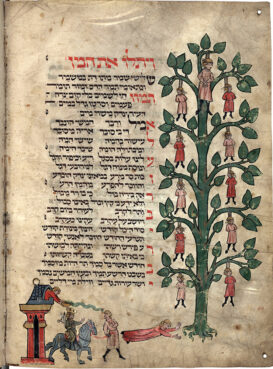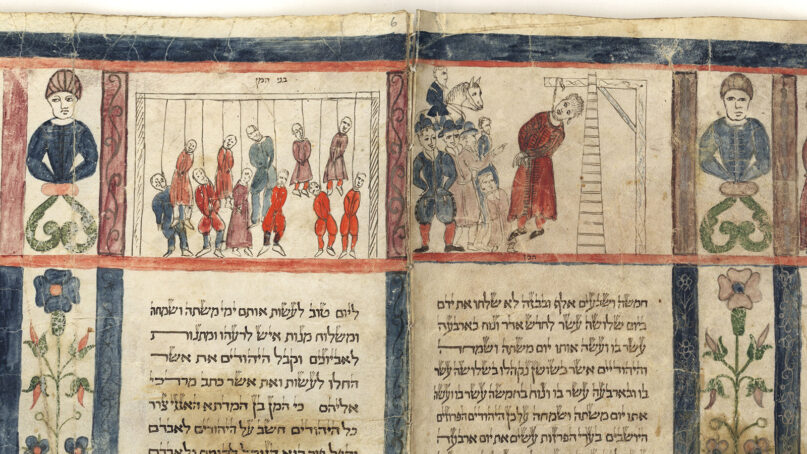(RNS) — They called it “the night of the spilled wine.”
Or, at the very least, I did.
It was at a Shabbat service in late February 1994, 30 years ago. It was our synagogue custom to invite members to join in the kiddush, the ritual blessing of the wine on Friday evenings, and to have some small thimbles of red wine.
Except, as I lifted the silver goblet of wine, I spilled most of its contents out onto the tray.
I announced: “We are doing this, precisely as we would do this during the Passover Seder when we recite the plagues that befell the Egyptians. This evening, we must diminish our Shabbat joy.”
Why? Because several days before that, on Feb. 25, 1994, which coincided with Purim, Baruch Goldstein, a fanatical Jewish settler in the West Bank, opened fire on Muslim worshippers at the Cave of the Patriarchs in Hebron. He killed 29 people, with 125 people injured.
Horrifically, his legacy lives on. Jewish extremists have turned his grave into a place of veneration. For years, Israel’s Minister for National Security, Itamar Ben-Gvir, displayed Goldstein’s portrait in his living room. He has since taken the portrait down, but I suspect that it still has a place in his heart.

A medieval manuscript depicts the hanging of the 10 sons of Haman. (Image courtesy National Library of Israel/Wikimedia/Creative Commons)
What would have possibly inspired Goldstein to perpetrate this lasting stain on Jewish morality?
Let’s go to Purim, which Jews will celebrate this Saturday evening. If you’re Jewish, you know the drill. We read Megillat Esther, the scroll of Esther, which tells the story of how Haman influenced King Ahasuerus of ancient Persia to let him do away with the Jews of his realm — only to be foiled by the Jewish Queen Esther and her cousin/uncle, Mordecai. We use graggers (noisemakers) to blot out the name of the genocidal villain, Haman. People dress in costumes. People even drink to excess, in order to get drunk.
I suspect most congregations stop reading the story of Esther right after the 10 sons of Haman are hung. You are supposed to read their names in one breath, as if to say they are not worth much more of your oxygen than that.
But, if congregations would get to the very end of the story, it would shock them.
So, let’s go to Esther, chapter 9:
On the thirteenth day of the twelfth month — that is, the month of Adar — when the king’s command and decree were to be executed, the very day on which the enemies of the Jews had expected to get them in their power, the opposite happened, and the Jews got their enemies in their power. Throughout the provinces of King Ahasuerus, the Jews mustered in their cities to attack those who sought their hurt; and no one could withstand them, for the fear of them had fallen upon all the peoples … So the Jews struck at their enemies with the sword, slaying and destroying; they wreaked their will upon their enemies. In the fortress Shushan the Jews killed a total of five hundred men (and the text continues by listing the ten sons of Haman who were also hanged) … The rest of the Jews, those in the king’s provinces, likewise mustered and fought for their lives. They disposed of their enemies, killing seventy-five thousand of their foes; but they did not lay hands on the spoil.
Well, at least “they did not lay hands on the spoil.” At least they could not say the Jews were greedy.
But no doubt about it. Throughout history, this ending of the story has not been “good for the Jews.”
- In the 1500s, the Protestant reformer, Martin Luther, thought this story epitomized the blood-thirsty and vengeful nature of the Jews.
- In the late 1700s, a biblical scholar, Johann David Michaelis, noted that Haman had been executed without trial, which demonstrated why the Jews should never have equal rights.
- Also in the 1700s, Wilhelm Martin Leberecht de Wette of the University of Berlin, one of the giants of 19th-century biblical scholarship, criticized Esther’s “bloodthirsty spirit of revenge and persecution.”
- His student Friedrich Bleek referred to the book’s “very narrow-minded and Jewish spirit of revenge.”
In other words: If you think the Jews are not nice people, the end of the book of Esther will cement that for you.
It was precisely for this reason — and the raucous, indecorous nature of the celebrations — that early Reform Jews frowned upon Purim.
It wasn’t nice.
Those accusations led the Jews to defend themselves — not against their enemies, but against their critics.
- First: the story is most likely fiction. Historical fiction, based on a real king (Ahaseurus was most likely Xerxes), but fiction nevertheless.
- The whole revenge thing? Jewish commentators taught that this was a legal fiction, or even a satire on a legal fiction. After all, why did King Ahasuerus let the Jews do this? Because he had already issued an edict allowing Haman to destroy the Jews, and even as king he could not reverse an earlier edict. So, he had to issue a second edict, allowing the Jews to defend themselves.
- And the Jews of Shushan killed 75,000 Persians in self-defense? Really? And that little bloody fact never made it into the annals of Persian history?
Let’s get back to that troublesome passage toward the end of the book of Esther.
It is not as if that passage is the only problematic, morally troublesome text in the Hebrew Bible. There are many such “texts of terror” (as Phyllis Trible put it) — the Jewish equivalent to the “hard sayings of Jesus.” Deuteronomy is filled with belligerent texts about conquering and destroying Canaanite cities (historically and archeologically quite questionable). Psalm 137 ends with a hope that the Babylonians, who had destroyed Judea, would witness their own children smashed against a rock. Ouch — to put it mildly.
So, what do we do with this material?
First, I am borrowing an image from traditional Jewish theology. The human being is endowed with two conflicting drives: the yetzer ha-tov, the good inclination, and the yetzer ha-ra, the not-so-good inclination.
What is true of human beings is also true of religions. Every religious tradition has its good part and its not-so-good part. Every religion has dueling voices within it. (Think: Luke Skywalker vs. Darth Vader, who, of course, winds up being Luke’s father, which only complicates matters a little further.)
- Christianity has Torquemada, the Grand Inquisitor in medieval Spain, and also Mother Teresa — and everything in between.
- Islam has the execrable Hamas, and also the gentle Sufi poet, Rumi — and everything in between.
- Judaism has Rabbi Meir Kahane, and also Rabbi Abraham Joshua Heschel — and everything in between.
Which voice is the “genuine” voice?
That, ultimately, is up to the believer — what they want to hear and what they want to embody.
Second, often in Jewish history, Jews have faced persecution, and they said and did some ugly things. Jews included texts in their liturgies that some would call xenophobic — many of which have since wound up on God’s cutting room floor.
Why? When you’re powerless, and you lack the ability to physically retaliate, you retaliate in your souls and through your words. You create revenge fantasies.
It is like what director Quentin Tarantino did in his film “Inglourious Basterds,” which is an alternative history in which a team of Jewish soldiers and a survivor conspire to eliminate the leadership of the Third Reich.
(To further complicate matters: this is the fantasy of a gentile director about how Jews should take revenge. “Django Unchained” is basically the same movie, from the vantage point of American Black history.)
Third, rather than apologize for those ugly texts, let’s try a different tactic.
Let’s go back to the yetzer ha-tov and the yetzer ha-ra.
We have both of those inclinations within us. In reality, we cannot reject either of those inclinations — especially, the yetzer ha-ra. The best we can do is to hold it in check and in balance.
This is what I now believe about those difficult texts. Just as we possess and own the dark parts of ourselves, so, too, we must possess and own the dark parts of our tradition.
They are part of us. We cannot entirely reject them. We can only hold them in balance.
Which is what we seek to do.
To all: a joyous Purim!
This year, we need it more than ever.






